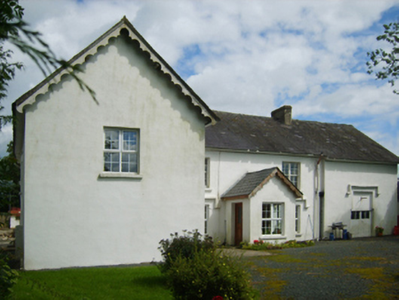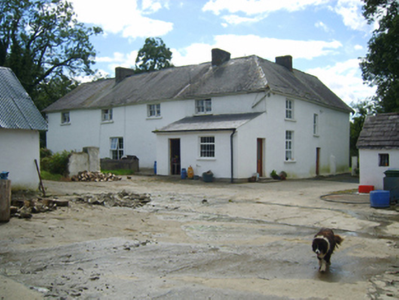Survey Data
Reg No
15701703
Rating
Regional
Categories of Special Interest
Architectural, Artistic, Historical, Social
Original Use
Farm house
In Use As
Farm house
Date
1842 - 1900
Coordinates
316321, 149783
Date Recorded
15/08/2007
Date Updated
--/--/--
Description
Detached five-bay two-storey farmhouse, extant 1900, on an F-shaped plan centred on single-bay single-storey gabled projecting porch to ground floor with single-bay full-height gabled projecting end bay; four-bay two-storey rear (east) elevation. Part refenestrated, ----. Pitched slate roof on an L-shaped plan; pitched (gabled) slate roof (porch), roll moulded clay ridge tiles, paired rendered central chimney stacks having rendered red brick stepped capping, decorative timber bargeboards to gables on timber purlins, and no rainwater goods on slightly overhanging rendered eaves. Rendered walls. Central door opening into farmhouse. Square-headed window openings in bipartite arrangement with cut-granite sills, timber mullions, and concealed dressings framing four-over-four timber sash windows with replacement uPVC casement windows throughout. Square-headed window openings in bipartite arrangement to rear (east) elevation with cut-granite sills, timber mullions, and concealed dressings framing replacement uPVC casement windows (ground floor) or two-over-two timber sash windows (first floor). Set in landscaped grounds.
Appraisal
A farmhouse representing an integral component of the nineteenth-century domestic built heritage of Killenagh with the architectural value of the composition, one repurposing a mill annotated as "Killenagh Corn Mill" on the first edition of the Ordnance Survey (surveyed 1839; published 1841), suggested by such attributes as the angular plan form centred on an expressed porch; the diminishing in scale of the openings on each floor producing a graduated visual impression with those openings showing elegant bipartite glazing patterns; and the decorative timber work embellishing the roofline. Having been well maintained, the elementary form and massing survive intact together with substantial quantities of the original fabric: the piecemeal introduction of replacement fittings to the openings, however, has not had a beneficial impact on the external expression or integrity of a farmhouse having historic connections with the Black family including John Black (d. 1900) 'Farmer late of Raheenbeg County Wexford' (Calendars of Wills and Administrations 1900, 25; cf. 15700324).



